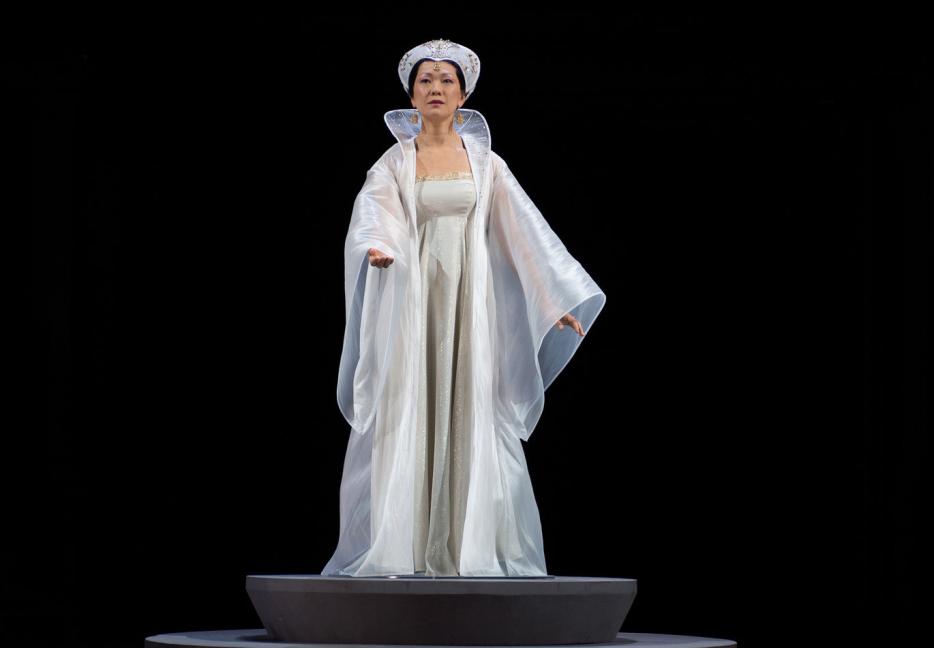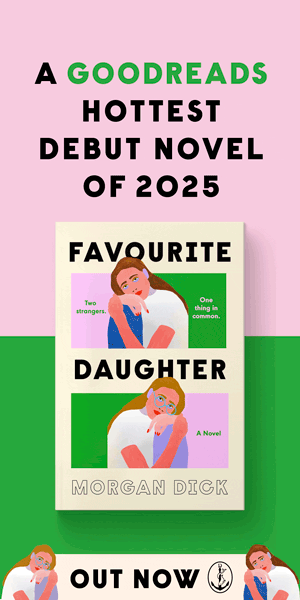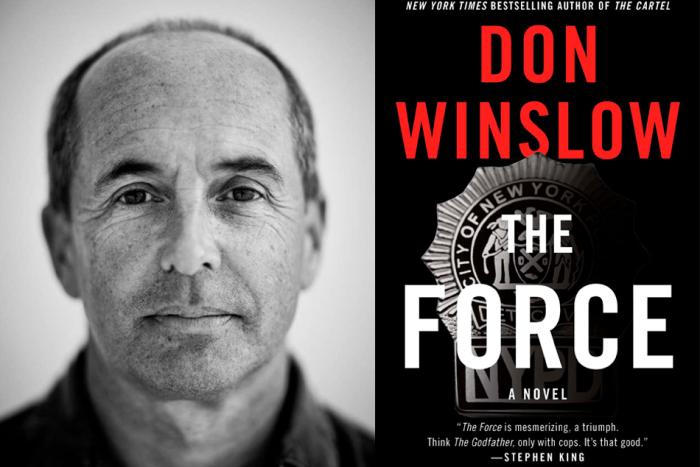I was nine or ten years old when I saw Twelfth Night—my first Shakespeare play—at the Oregon Shakespeare Festival. By then I knew what a protagonist looked like (white, thin, conventionally attractive), and I knew I was supposed to care most about the talented and golden-haired young woman playing both Viola and her twin brother Sebastian. But the actor playing Olivia happened to be Asian—the first Asian actor I had ever seen onstage, and one of precious few I’d noticed anywhere. Regal and beautiful in her long black dress, I watched her sweep across the stage with a sense of wonder and expanding, exciting possibility I didn’t yet know how to name.
I like to refer to the OSF as “my hometown Shakespeare festival,” even though Ashland, Oregon is technically not my hometown, just near it, and when I was growing up my family could almost never afford tickets. Last year, when Julie Cortez in the OSF communications office connected with me via the sorcery of Twitter, I was already planning a summer visit home and seized her offer of complimentary tickets with a flurry of grateful exclamation points. Then I wondered: Should I take my kids to the theatre, too? My then-five-year-old was too young, I decided, and would fall asleep an hour into the play. But my eight-year-old was only a year or two younger than I had been when I was introduced to Shakespeare; she’d been reading chapter books since kindergarten; she could probably infer a great deal, even if she missed a lot of the dialogue.
As I clicked through the season’s offerings online, I found myself reading with an eye toward which of the productions might be, if not kid-friendly, then at least kid-accessible. The image for The Winter’s Tale immediately caught my eye: Queen Hermione, half herself and half in marble, a statue blooming to life. This Hermione, I saw, was played by a Korean American actor named Amy Kim Waschke. The production, directed by Desdemona Chiang, was described as The Winter’s Tale “from an Asian and Asian American perspective,” and the cast featured Asian American artists in a majority of the lead roles.
I felt sure my serious, bookish older child was enough like me to enjoy her first Shakespeare play. I talked with a friend back home who’d already seen the production; he assured me there was nothing in it an eight-year-old couldn’t handle. Maybe warn her about the bear? he suggested. My mother asked why I didn’t just take her to see Twelfth Night instead.
Of course, I thought, I could do that; Twelfth Night is livelier, funnier, and there are no bears. At first blush, bringing an eight-year-old to one of William Shakespeare’s quirkier plays in an effort to help her see herself, an Asian American girl, in popular culture did seem a rather odd decision. But then I remembered the flash of delighted surprise I felt when I saw my first Olivia: the same surprise I felt, still feel, whenever I catch a glimpse of a fellow Asian in a place I did not expect.
*
Thanks to the books I read and the shows I watched as a kid, I was convinced that whiteness was practically a prerequisite for agency, adulation, protagonism in a story. Now that I’m a parent, I sometimes wonder if that’s what my kids will think, too, despite everything we tell them to the contrary. Sure, it’s a little better than it once was, but pop culture is still so lacking in the diversity—the reality—kids deserve. What and who does my daughter see reflected most often in the novels she devours? How often do my kids find themselves in the media they consume?
Last year, when the hashtag #WhitewashedOut drew attention to controversial film casting decisions and the still-sorry (if slowly improving) state of Asian American representation in pop culture, I tweeted something about how I wanted better than this for my children. I’m an adult, after all; I can deal with a degree of invisibility—I’m used to it. But children need and deserve to feel important, to feel seen. My tweet, which truly seemed like the most innocuous, unassuming thing I could have contributed to the discussion, led to me blocking racist abuse for days and garnered me my first Twitter death threat.
I get tired of thinking about this, tired of talking about it, tired of the rage I encounter when I do. Occasionally I give up on searching for new movies or shows for the kids, which is why we watch Moana and Big Hero 6 (still the only movie my children have ever seen that features a multiracial Asian kid like them) over and over and over. I keep a list of Asian American children’s book authors, and pester friends for recommendations—bonus points if the stories don’t all revolve around cultural conflict or racial trauma. I buy every book I can find with an Asian American girl protagonist. For all my effort, it still comes to probably less than one percent of what my kids read.
Perhaps it’s not so surprising, then, that when I had the chance to take my daughter to see a company teeming with Asian American Shakespeareans, I grabbed it—even if it was “too weird” and “too old” for her; even if the original source material wasn’t written with her in mind at all. She didn’t know anything about the play, but she knew she would get to stay up very, very late, so of course she wanted to go. I bought her an abridged version of The Winter’s Tale written for children, dreamy fairy-tale illustrations filling every page, so she would go in with a basic grasp of the plot. She might not know Shakespeare yet, I thought, but she would—she’d be assigned his plays in school and see them performed onstage, on film. And now she would always be able to look back and recall that the first time she ever saw a Shakespearean play, many of the people bringing the story to life before her eyes were Asian American. Just like her.
*
Our seats were just eight or ten rows back in the open-air Allen Elizabethan Theatre. My daughter and I dressed up for the play—she wore a new navy-blue dress with white polka dots—though it was southern Oregon and no one cared what we wore. I bought popcorn and cookies and bottled water from the concessions counter, and the two of us snapped selfies while waiting for the trumpet fanfare that would announce curtain time.
The first time my daughter tugged my sleeve was when the girl playing Prince Mamillius (Naomi Nelson) appeared in the first scene; though my daughter knew the prince’s fate, she was still so excited to see this child actor around her own age, who actually resembled her a little, running around onstage in costume. She nudged me again when Paulina (played Miriam A. Laube) let loose, upbraiding King Leontes (Eric Steinberg) for allowing his jealousy to destroy his family—What studied torments, tyrant, hast for me? My daughter could tell it was an important scene, but couldn’t follow the dialogue. “She’s saying that he’s a big jerk,” I murmured. “Now she’s listing all the reasons why he’s a big jerk.”
From the high drama of Leontes’s rage to the depths of his grief, we watched for the revelation of Perdita, her restoration to her family. I don’t go home often, so for me it was Perdita’s absence and her strange homecoming, accidental and unlooked-for, that resonated more than anything else. In our production, Perdita was played by a wonderful actor named Cindy Im, whose singing talents were on display during a Bohemian hoedown scene (this was likely the only production of The Winter’s Tale to ever feature a hoedown). Just as she did for Mamillius and for Hermione, my daughter perked up during all of Perdita’s speeches and songs. Later, she would tell me Perdita was her favorite.
As we watched actors of three different generations portray mother, father, daughter, and little son, I tried to remember the last time I saw so many Asian American women in a single work. After a while, though, I realized I was focusing less and less on the fact that they were Asian. It wasn’t that I stopped noticing or caring. But after the initial surprise wears off, seeing so many Asian American actors at once becomes utterly unexceptional. They simply are their characters, as all skilled actors are when performing; their presence makes a perfect kind of sense. As we watched not one but so many Asian American artists command the stage, feuding and scheming and falling in love as great characters do, it made me wonder why something so easy has to be so rare.
Stars shone high above the stage by the time the company took their bows. My sleepy child told me that she didn’t believe Hermione was alive all along, in hiding and pretending to be a statue. She thought the queen had died, and then been revived by magic. “You said this story was kind of like a fairy tale,” she said, “and in fairy tales, magic isn’t strange at all. It’s just normal.”
*
“I feel there are two distinct parts of myself, an American me and a Chinese me,” says Desdemona Chiang, who directed the production of The Winter’s Tale my daughter and I saw at OSF. She was born in Taiwan and moved to the U.S. at age three, and describes her upbringing in southern California as “a classic hyphenated experience.” “When I was thinking about The Winter’s Tale, I kept thinking about these two places, Sicilia and Bohemia, how the play is really about dual cultures, polarity—cold and warm, kings and peasants,” she tells me. “I thought, what if we add East and West?”
In the production, Bohemia is a multicultural New World immigrant utopia, and Sicilia is “a kind of Asian Pangaea” represented by a diverse group of Asian American artists. “When you cast an all-white cast, you’re casting a racially specific show, too—we just don’t think of it that way because we’ve normalized whiteness in this country,” Chiang says. “With race-conscious casting, like we had, we’re not ignoring race. We had all these different aspects of Asianness in the company: a Korean Hermione, Korean and Filipino lords, a South Asian Paulina. So Asian American identity, the nuances of diaspora and migration—all of these topics were part of the conversation with the company from the beginning.”
It was important to Chiang to have a predominantly Asian American creative/design team as well, including dramaturg Gina Pisasale and costume designer Helen Q. Huang. “Representation is about the bodies on the stage, yes, but who makes the choices about what plays to produce in the first place? Who’s directing, who’s designing the sets and costumes, who’s doing the casting?” For Pisasale, it was the first time she had been in a room with so many Asian theatre artists. “The joy in the rehearsal room was real,” she says. “Beyond telling the story, many of us were also thinking about our own relationship to our history and our Asianness and how to bring those things into this production.”
When I tell Chiang how thrilled my daughter was to see Perdita and Mamillius, she says she had a similar experience attending a high school production of Twelve Angry Men. “It was Twelve Angry Jurors,” she explains, “because there were also girls in the company. The lead juror was a young Asian woman. And I had this amazing moment: ‘oh my god, someone who looks like me is playing this important character onstage.’”
Chiang and Pisasale highlight the importance of supporting Asian American creators and playwrights and ensuring their works are part of the theatre ecosystem. Yet as Pisasale points out, presenting an iconic work of Shakespeare’s from an Asian and Asian American perspective can help poke holes in the very idea of “the Western canon” and what it means—and such interrogation is a good, even necessary thing. “Making these bodies visible onstage is a huge political and artistic step forward,” she says. “What I always think, and what I think about even more since the election, is the larger global and national and local context for what we see onstage. When you’re asked to bring your full self to an artistic collaboration, instead of only the Asian part or only the artist part—there’s something liberating in that. From the audience perspective, it’s important because of possibility: This wasn’t possible before, and now it is, and we go from here. Your daughter’s experience is why it’s important.”
*
There are so many different types of inheritances; one I still hope my children can somehow sidestep is the void, the frustration of desperately searching for yourself, or people like you, in a cultural landscape that does not seem to be for you. And what does it say about you, about your worth and your importance and the possibilities open to you, if you can’t find yourself at all? Something I think about, often, as I watch my multiracial Asian American kids growing up in Trump’s America: There are millions of racist people in this country; millions of reasons for them to want to be white. Against the current political backdrop, my kids are already observing, acquiring so many products doled out by Hollywood, book publishers, the media—products full of insidious and unsubtle messages about what and who is most important, desirable, praiseworthy. My older daughter is well aware of precisely who this administration stacked with grade-school bullies views as worthwhile, “real Americans.”
I worry a little more these days because my children aren’t white; I also worry because one day, regardless, they could still attempt to seek the privilege and safety of whiteness—or as much of it as the white people around them will allow. It’s not a choice I’d ever want them to make. But I would not have to ask why they made it.
I don’t know if my urgent attempts to find them the stories and examples I never had—even if there still aren’t enough of them—will make any kind of difference at all as they grow and learn who they are and where they belong. I don’t know how much I can help them feel important, seen as they are, without limitation or a care for other people’s biases. But I know I will continue to seek out these examples of representation for them as if their lives and identities depend upon it, because I’m convinced they might.
I’m still glad that, from now on, when my daughter thinks of Shakespeare, she’ll be able to imagine Asian American players. I will always remember the Olivia I watched, years ago, in such thrall; what it meant to see someone who looked a little like me sweep across the stage wearing a gorgeous costume, speaking beautiful words I barely understood, on her way to securing her love and her due. As my bibliophile daughters grow up, as they go on their own pagebound adventures, I want them to believe that these works of art and imagination belong to them as much as anyone else. I want them to be able to envision stage after stage, world after world of people they, too, can become.






